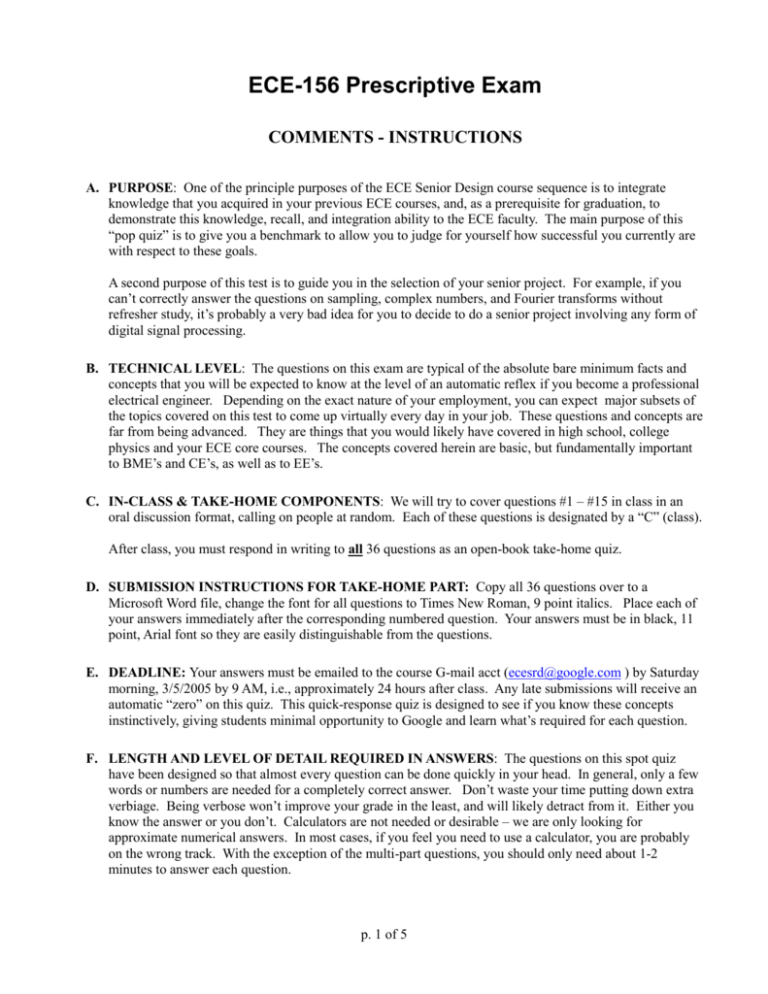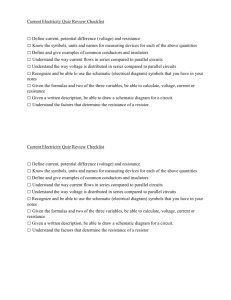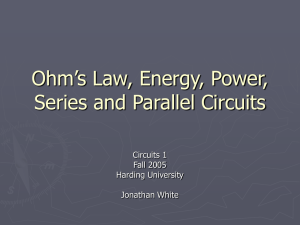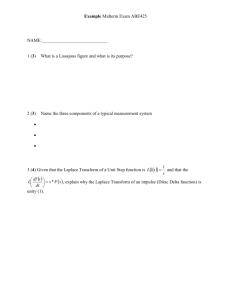ECE-156 Prescriptive Entry Exam
advertisement

ECE-156 Prescriptive Exam COMMENTS - INSTRUCTIONS A. PURPOSE: One of the principle purposes of the ECE Senior Design course sequence is to integrate knowledge that you acquired in your previous ECE courses, and, as a prerequisite for graduation, to demonstrate this knowledge, recall, and integration ability to the ECE faculty. The main purpose of this “pop quiz” is to give you a benchmark to allow you to judge for yourself how successful you currently are with respect to these goals. A second purpose of this test is to guide you in the selection of your senior project. For example, if you can’t correctly answer the questions on sampling, complex numbers, and Fourier transforms without refresher study, it’s probably a very bad idea for you to decide to do a senior project involving any form of digital signal processing. B. TECHNICAL LEVEL: The questions on this exam are typical of the absolute bare minimum facts and concepts that you will be expected to know at the level of an automatic reflex if you become a professional electrical engineer. Depending on the exact nature of your employment, you can expect major subsets of the topics covered on this test to come up virtually every day in your job. These questions and concepts are far from being advanced. They are things that you would likely have covered in high school, college physics and your ECE core courses. The concepts covered herein are basic, but fundamentally important to BME’s and CE’s, as well as to EE’s. C. IN-CLASS & TAKE-HOME COMPONENTS: We will try to cover questions #1 – #15 in class in an oral discussion format, calling on people at random. Each of these questions is designated by a “C” (class). After class, you must respond in writing to all 36 questions as an open-book take-home quiz. D. SUBMISSION INSTRUCTIONS FOR TAKE-HOME PART: Copy all 36 questions over to a Microsoft Word file, change the font for all questions to Times New Roman, 9 point italics. Place each of your answers immediately after the corresponding numbered question. Your answers must be in black, 11 point, Arial font so they are easily distinguishable from the questions. E. DEADLINE: Your answers must be emailed to the course G-mail acct (ecesrd@google.com ) by Saturday morning, 3/5/2005 by 9 AM, i.e., approximately 24 hours after class. Any late submissions will receive an automatic “zero” on this quiz. This quick-response quiz is designed to see if you know these concepts instinctively, giving students minimal opportunity to Google and learn what’s required for each question. F. LENGTH AND LEVEL OF DETAIL REQUIRED IN ANSWERS: The questions on this spot quiz have been designed so that almost every question can be done quickly in your head. In general, only a few words or numbers are needed for a completely correct answer. Don’t waste your time putting down extra verbiage. Being verbose won’t improve your grade in the least, and will likely detract from it. Either you know the answer or you don’t. Calculators are not needed or desirable – we are only looking for approximate numerical answers. In most cases, if you feel you need to use a calculator, you are probably on the wrong track. With the exception of the multi-part questions, you should only need about 1-2 minutes to answer each question. p. 1 of 5 G. If a particular question is completely foreign to you because you have not yet had a course in a particular area (e.g., the BME students might not have taken a course in electromagnetics), just write, “No course”, and move on to the next question. H. Your grade on this pop quiz suggests how well prepared you are to successfully complete the 156/7/8 sequence, and which areas of ECE you need to work on. Your grade on this quiz will contribute to your overall grade in ECE-156. p. 2 of 5 QUESTIONS 1. C - BASIC ACTIVE COMPONENTS / CIRCUITS: What is the gain of a theoretically ideal op-amp? In the standard inverting op-amp circuit (ideal components, R_in = 10 K R_feedback = 100 K, V_in = 0.1 volts), what is voltage at the inverting input to the op-amp? What is the output impedance with ideal components? 2. C - BASIC CS: What is the output of a compiler? What are the inputs and output of a linker-loader? 3. C - BASIC E/M PHYSICS: How does the resistance per foot of a piece of wire depend on its diameter? Just the proportionality relationship will be fine. The full formula is not needed. 4. C - BASIC E/M/OPTICAL PHYSICS: Explain why the sky is blue above, but the sun is red when it is near the horizon. 5. C - BASIC EE PHYSICS: Is the outer shield (e.g., copper braid) on a coaxial cable more effective against capacitive or magnetically coupled interference? 6. C - BASIC EE: Why are 110 VAC power wires larger in diameter than wires carrying signals inside of electronic equipment? 7. C - BASIC RF: What are the approximate frequencies and wavelengths of the AM, FM, TV and microwave bands? 8. C - BASIC SIGNAL PROCESSING: You have designed a basic microphone sensor that outputs the heartbeat signal in the range of mV’s. This signal must be digitized. Which of the following sampling frequencies is more sensible to choose? (a) 1 Hz, (b) 10 Hz, (c) 10 kHz, (d) 1 MHz. 9. C - BATTERIES: The MP3 player that you are thinking of building as your senior project requires 100 mA at 9 vdc to operate. What specification for a 9 volt battery would you have to examine to determine roughly how long the battery might last. Hint: Obviously the battery has to be able to put out 9 vdc at 100 mA. Lets assume it does. However, neither of these are the specification that I am looking for. 10. C - EE MATH: Define dB in terms of voltage; in terms of power. 11. C - ELEMENTARY CIRCUITS - RESONANCE: What is the condition that determines at what frequency an LC circuit is resonant? What is the formula for the resonance frequency? 12. C - ELEMENTARY DIGITAL CONCEPTS: The spec sheet for an A-to-D converter says it has 8 bit resolution and accepts input (i.e., signal) voltages from –5 to +5 volts. How many distinct voltage levels can it represent? 13. C - MATH: If you integrate a delta function, what do you get? What if you integrate a “doublet”? p. 3 of 5 14. C - NUMERICAL ACCURACY: A heart beat monitor has a 3-digit LCD display corresponding to 000 to 999 beats per minute. Can one conclude that the accuracy of this device is +/- 1 bpm? 15. C - POWER SYSTEMS: Is the voltage output of a linear voltage regulator more or less than the input voltage? 16. BASIC ACTIVE COMPONENTS / CIRCUITS: Consider a common emitter BJT amplifier stage and a common source MOSFET amplifier stage. Which configuration can be more easily designed to have a higher input impedance? Roughly what values might one expect for the two input impedances? 17. BASIC ACTIVE COMPONENTS / CIRCUITS: Draw a circuit for a simple op-amp adder with three inputs, each with a gain of -10x and an input impedance of 10 K.. 18. BASIC E/M PHYSICS: Explain why the electric field, E, is zero inside a conductor. 19. BASIC E/M PHYSICS: How does the capacitance of a parallel plate capacitor depend on the area of the plates? Just the proportionality relationship will be fine. The full formula is not needed. 20. BASIC MECHANICS: What are typical (ie, metric or English) units of torque, linear acceleration, angular acceleration? 21. BASIC RF: Can the phase velocity of a wave be faster than the speed of light? What about the group velocity? 22. BASIC RF: What is the approximate impedance of free space? What is the speed of propagation of a wave in free space? (either numerical or a formula is fine) 23. BASIC RF: Which of these types of waves can exist in the far field of an antenna: TE, TEM, TM? 24. BASIC SIGNAL PROCESSING: The Nyquist sampling theorem states that one must sample an analog signal (for instance a heartbeat signal) at a frequency of at least twice the highest frequency component of the analog signal. What are the repercussions if you don’t follow this rule? 25. BASIC SIGNALS: (a) A 1 volt, 1 MHz sinusoidal signal is fed to a diode in series with a moderate value resistor. The voltage across the resistor is measured as a function of time. What frequencies will appear? (b) What are the two main frequencies of concern when you “beat”, “mix” or “heterodyne” (all three are synonyms) two AC signals together with frequencies 1 and 2? 26. DIGITAL CIRCUITS: What’s the difference between a microprocessor and a microcontroller? 27. ELEMENATRY DIGITAL CONCEPTS: A student’s data recorder project needs to store 100 seconds of uncompressed 8 bit data which is to be over-sampled at 100 kHz. How much memory is needed? What sustained data rate (in bits per second and bytes per second) is needed? One microcontroller takes 1 microsecond (on average) to execute each of the 20 separate operations needed to store one byte of data. Will this particular micro be fast enough for this project? p. 4 of 5 28. ELEMENTARY CIRCUITS - RESONANCE: A 1 F capacitor, a 1 H inductor, and a 1 resistor are all connected in series with a 1 volt RMS AC voltage source. a) At omega = 1 radian per second, how much voltage appears across the resistor? b) At omega = 109 radians per second, how much voltage appears across the resistor? c) At omega = 106 radians per second, how much voltage appears across the resistor? d) If the 1 volt AC source is regarded as the input and the voltage across the resistor is regarded at the output of the above circuit, what one term from circuit theory is most appropriate to describe the action of the circuit regarded as a black box in transforming the input signal to an output signal. Hint: Terms like impedances or resonance may describe what’s going on inside the box, but this is not what I’m looking for. e) The same components are now all connected in parallel across the voltage source. What is the voltage across the resistor at each of the above frequencies? f) Same as (e), but the voltage source has been replaced by an AC current source. Is the voltage across the components a maximum, a minimum, or some intermediate value at the intermediate frequency of omega = 106 radians per second? 29. ELEMENTARY CIRCUITS: A 1 F capacitor is charged to 10 volts. It is discharged through a 1 K resistor. Roughly (ie, accurate to 20% is fine if you show your steps) how long will it take for the voltage to drop to 1 volt? How much current will go through the resistor when it is first connected? 30. ELEMENTARY CIRCUITS: What is the formula for the impedance of a capacitor? 31. ELEMENTARY CIRCUITS: What is the formula for the impedance of an inductor? 32. ELEMENTARY DIGITAL CONCEPTS : The spec sheet for an A-to-D converter says it has 8 bit resolution and accepts input (i.e., signal) voltages from –5 to +5 volts. What is it’s voltage resolution? Show how you obtain your answer. Don’t bother using your calculator to get an accurate numeric answer, an estimate to within 20% will be fine if you show your steps. 33. MATH: Expand exp( j t) in terms of modulus and phase angle. 34. NOISE: A student is designing an electronic stethoscope (i.e., a low signal level audio frequency system). Name as many distinct types / sources of noise that you can think of that might impact the design. Comment on the frequency range typical of each source of noise. 35. NUMERICAL ACCURACY: Three valves are supplying water to a tank at the rate of 1.2578, 10 and 50 gallons per minute. Can we conclude that the water in the tank is increasing at 61.2578 gallons per minute? Why, or why not? 36. UNITS: One fortnight is approximately 10 days. One day is approximately 100,000 seconds. One furlong is approximately 0.1 mile. There are approximately 1.5 kilometers in a mile. Using the above approximate conversion factors, please convert 1 furlong per fortnight to MKS units (ie, meters per second). Show your steps. p. 5 of 5







